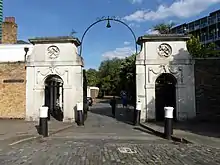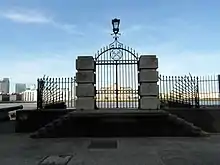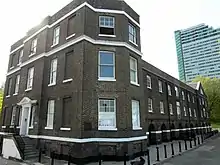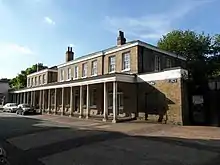HM Victualling Yard, Deptford
HM Victualling Yard, Deptford was a Royal Navy Victualling Yard established alongside Deptford Royal Dockyard on the River Thames. There was victualling activity on the site for the best part of 300 years from the mid-17th century through to the early 1960s.

Initially known as the Red House, Deptford, the Victualling Yard was rebuilt in the late 18th century and became 'the largest food-processing operation in Britain, if not in Europe'.[1] Deptford's proximity to the food markets of London made it especially convenient for victualling, and it served the requirements not only of its own neighbouring Dockyard, but also those of Woolwich, Sheerness and Chatham (as well as the Victualling Yard in Gibraltar for a time).[2] After 1858 it was formally known as the Royal Victoria Victualling Yard.
Origins: the Red House

In the 17th century the Navy Board's victualling operation was based on Tower Hill in a complex of offices, residences, storehouses and manufactories which had been established in the reign of Elizabeth I. In 1650, to supplement these arrangements, a slaughterhouse was acquired by the Board of Victualling of the Commonwealth Navy, across the river and downstream, at Deptford.
After the Restoration a private contractor, Sir Denis Gauden, was licensed as Surveyor of Marine Victuals. In 1665, with the Navy expanding rapidly, Gauden sought to ease pressure on the facilities at Tower Hill. He leased a property known as the Red House (a red brick storehouse which stood on a wharf adjacent to the Royal Dockyard). It first required rebuilding, having been damaged by fire in 1639;[3] but in 1673 Gauden began to transfer a number of personnel and operations from Tower Hill to Deptford.[4]
The Red House was part of the Sayes Court estate. In the hands of private contractors, it continued to be used for naval victualling for the next 70 years; but in 1743 the Victualling Commissioners themselves acquired the lease with the intention of establishing their main depot there. That same year, plans were drawn up for a comprehensive redevelopment of the 11-acre site, designed to consolidate in a single location facilities for the purchase, production, packing and dispatching of foodstuffs, beverages and other victualling supplies for naval use (as well as providing residential and office accommodation for the Victualling Commissioners themselves). Over the next few decades, although victualling activity increased at Deptford, it is not certain to what extent these plans were realized.[1]
Fire remained a serious threat in this period; the yard is recorded as having caught fire in 1726, 1748, 1755, 1758 and 1761.[3]
Expansion: HM Victualling Yard

It was only in the 1780s that HM Victualling Yard, Deptford, acquired the layout, scale and complexity of operations that it was to retain for the best part of the next two centuries. A comprehensive rebuilding took place, to designs by James Arrow (Surveyor to the Victualling Office, 1774-1785).[5] Behind a row of riverside storehouses, the yard's various activities were accommodated in a variety of purpose-built manufacturing areas and specialised storage buildings, arranged around a central open space. To the south was the cooperage (for the manufacture and repair of barrels, in which the great majority of the yard's products were packed for storage and transport). To the west was a large meat processing area, with separate slaughterhouses, cutting houses and packing houses for beef and for pork. To the north, alongside a terrace of houses for senior officers, was a large brewhouse providing beer for the fleet, and towards the centre a bakery with twelve large ovens, which produced bread and ship's biscuits.[2]
In 1785 the Victualling Board closed the Tower Hill depot and Deptford became its centre of operations (though the commissioners themselves did not move to Deptford, instead transferring their office to Somerset House in 1787).
Operation
Certain provisions were purchased locally and then stored on site, including butter, cheese, peas and fish, as well as malt and hops for brewing and flour for baking. (Initially, flour was milled by the Board in a pair of nearby windmills in Deptford and Rotherhithe, but by 1802 these had been sold as they proved uneconomical.)[6]
Livestock arrived either by boat or else on the hoof, usually from Smithfield Meat Market by way of London Bridge. The slaughterhouses only operated in the cooler months of the year (October-April). Fresh meat (and fresh bread) were provided for ships in harbour or at anchor in the Thames, the Medway and The Nore; for ships going to sea, salted meat was provided (and biscuit rather than bread).[1] Use was made of by-products: hides to make leather, tallow to make soap and candles, shins and bones to make portable soup.
One characteristic that distinguished Deptford from the Board's other manufacturing facilities (in Portsmouth and Plymouth) was that, in addition to the aforementioned large-scale facilities, Deptford specialised in the production of other foodstuffs on a smaller scale, such as mustard, pepper, oatmeal and chocolate (each prepared in a dedicated milling area). There were also separate storehouses for sugar, tea, rice, raisins, wine and tobacco, all of which were purchased in London and stored in Deptford prior to being distributed for use elsewhere as required.[1]
In the late-18th and early-19th centuries, during the French Revolutionary and Napoleonic Wars, Deptford's main task was to maintain a steady provision of victuals (either by manufacture or purchase) with which to supply the smaller yards on the south coast and overseas where the fleet was principally based.[6]
By 1813 the Victualling Yard at Deptford covered nearly 20 acres. A 10-horsepower steam engine had been installed in the brewhouse; it was used both to grind the malt and to pump beer from the vats. Furthermore, a complex network of pipes carried water from the Ravensbourne Waterworks into various parts of the yard, including the brewhouse, the bakehouse, the pickle-yard and the cooperage. Plugs were installed at various points, in case of fires, and attachments on the wharf-side cranes allowed water to be delivered directly to ships moored alongside.[2]
A steam-driven flour mill was introduced in the 1820s and biscuit making was semi-mechanised in the 1830s.[1]
Personnel

The senior personnel of the yard varied over time. Up to 1809, the Principal Officers of the yard were listed as follows:[6]
- Superintendent
- Hoytaker
- Clerk of the Cheque
- Clerk of the Cutting House
- Clerk of the Dry Stores
- Clerk of the Brewhouse
- Master Cooper
- Clerk of the Issues
These officers related directly to their counterparts on the Victualling Board, leading to a lack of co-ordination and accountability in the yard.
In response to this difficulty, a Board of Revision recommended in 1809 that the number of Principal Officers at Deptford be reduced to three:
- Agent Victualler (having overall responsibility for the yard's operation, for negotiating contracts and distribution of victuals)
- Clerk of the Cheque (financial officer)
- Storekeeper (overseer of items in store)
with the following listed as Subordinate Officers:

- Master Cooper
- Master Brewer
- Master Baker
- Master Butcher
- Principal Boatswain
- Principal Stevedore
- Inspector of Works
- Porter
In 1832 the Victualling Board was disestablished and the civilian Agent Victualler was replaced with a serving naval officer, the Captain Superintendent.
In 1868 the yard employed in addition 50 coopers, 7 millers, 21 bakers, 6 blacksmiths, 4 sawyers and 47 other tradesmen, together with 22 storemen and 67 labourers.[1]
Later years: the Royal Victoria Victualling Yard

Deptford remained the largest of the home victualling establishments through the 19th century. Its integrated approach to manufacture and storage provided a model for the new purpose-built victualling yards established in the 1820s: the Royal Clarence Victualling Yard, Gosport (which served Portsmouth and the south-coast anchorages) and the Royal William Victualling Yard, Stonehouse (which served Plymouth and later Gibraltar).
In 1858, following a visit by Queen Victoria, Deptford was renamed the Royal Victoria Victualling Yard. After the closure of Deptford's Royal Dockyard in 1869 the Victualling Yard expanded southwards into the old Dockyard precincts; by the end of the century it covered a total area of some 35 acres.[3]
Brewing had ceased in the yard after the beer ration was discontinued in the 1830s; and live animals were not brought into the yard after the 1870s (though fresh meat continued to be salted on site).[7] The old brewhouse instead became a clothing store, and in the 20th century a whole variety of stores were kept on site, including medical supplies, lubricating oil and acid as well as milk, jam and lime juice. The cooperage, however, remained in use as produce continued to be stored in barrels.
A. Cecil Hampshire wrote in the early 1970s:[8]
By the end of the Second World War the yard had become less and less of a storehouse, the functions of its staff being chiefly confined to inspecting and checking the quality.. of victualling stores.. all of which are today supplied by commercial firms. Certain quantities of dry and refrigerated provisions continued however to be held in stock, together with materials and uniform clothing, flying clothing and special cold-weather kit. At the final closure these were transferred to.. Portsmouth and Plymouth.
Closure

The Royal Victoria Victualling Yard closed in June 1961. Some staff (and stores) were relocated to the adjacent Army Supply Reserve Depot (which occupied part of the former Dockyard site).[9] The majority of the old Victualling Yard buildings were demolished; a large council estate, the Pepys Estate, was built on the site. Some historic buildings, all dating from the 1770-80s, were retained and converted for housing or community uses.[5] These include the gateway on Grove Street and behind it the 'Colonnade' (former houses and office, fronted by a colonnaded passageway), the terrace of former officers' houses on Longshore and the two former Storehouses on the riverbank.
See also
- Deptford Dockyard
- Royal Clarence Victualling Yard
- Royal William Victualling Yard
- Victualling Commissioners
References
- Coad, Jonathan (2013). Support for the Fleet. Swindon: English Heritage.
- Lavery, Brian (1989). Nelson's Navy: the Ships, Men and Organisation, 1793-1815. London: Conway Maritime Press.
- "Plans of the 'Red House', Deptford". The National Archives. Retrieved 24 November 2017.
- Davies, J. D. (2008). Pepys's Navy: Ships, Men and Warfare 1649-89. Seaforth.
- Pevsner, The Buildings of England - London 2: South (Yale University Press, 1983 & 2002).
- Macdonald, Jane (2010). The British Navy's Victualling Board 1793-1815. Woodbridge: Boydell Press.
- Walford, Edward. "Old and New London: vol. 6". British History Online. Cassell, Petter & Galpin, London, 1878.
- A. Cecil Hampshire (1975). The Royal Navy Since 1945. London: William Kimber & Co. Ltd. p. 209. ISBN 0718300343.
- HC Deb, 27 April 1960 vol 622 cc198-9
External links
- Early photograph of the Cooperage entrance, which faced the river gate across the yard at the end of a long avenue.
- View through the main gate towards the tree-lined central area of the yard.
- Elevated view of the main gate with the former livestock area beyond it.
Photographs of the river frontage, 1937 (south to north):
- Stationery Store
- New Stationery Store (left) and New Clothing Store (right).
- New Clothing Store (left) and entrance to the Wet Dock (formerly the Mast Pond of the Dockyard).
- Chocolate mill (left) and flour mill (right).
- Flour mill (left) and South Storehouse (right).
- Offices (left), Superintendent's house and North Storehouse (right).
- North Storehouse (left) and 'Old Storehouse' (right).
- 'Old Storehouse' (left) and Brewhouse (right).
- Brewhouse (centre) and Tobacco Store (right).
- Tobacco Store.